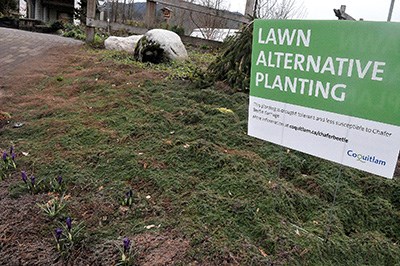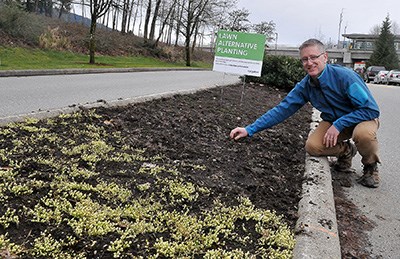Sometimes, in the face of overwhelming odds, you have to landscape your way out of a problem.
Coquitlam is giving it a shot by testing a grass alternative in two areas that have seen significant chafer beetle damage. The sedum, creeping thyme and pratia will spread in the boulevard at the entrance to the City Centre Aquatic Complex, creating a vibrant gold, red and blue covering that not only looks beautiful but is less susceptible to chafer infestations — and the pecking crows and raccoons that like to dig up chafer grubs.
"It's a challenging strip there," said Mike Por, the city of Coquitlam's landscape manager. "It has no irrigation, it sees a lot of people's feet and the grass had been attacked several years in a row by the chafer beetle. So we decided to plant something the chafer didn't like."
But Por didn't want to plant just anything. With last year's drought and ensuing watering restrictions still fresh in the minds of landscaping staff, Por selected plants that are far more drought-tolerant than grass and require little additional watering. They require minimal maintenance apart from a quick mow once they've flowered and start to look a little "shaggy."
"And we wanted to demonstrate what it could look like if people were looking for an alternative for lawn in their own yard," Por added. "You can't really play soccer on them but they'll take the occasional foot traffic."

The selected perennials are easy to grow, spread quickly and will produce small flowers — and plenty of interesting colour — from spring through fall. Similar plantings have also gone in across an area at the entrance to the Inspiration Garden at the southeast corner of Town Centre Park, near Guildford Way and Pipeline Road.
Coquitlam staff inventoried the city's chafer beetle-damaged areas last year and will soon be doing the same survey to compare the changes but Por suspects things are significantly worse this year.
"It's apocalyptic" in some areas of the city, he said.
It's a similar scene in Port Coquitlam, said Todd Gross, that city's manager of parks and services.
In preparation for a budget request for various options to manage the chafer beetle infestation, PoCo staff have completed an audit of damage on city parks, building landscapes and street boulevards, and found the damage spread significantly from 2015 to ’16. Most of the damage is to city turf in central and northern PoCo neighbourhoods, with much less in southern areas or Citadel Heights.
Staff have identified several options for chafer beetle management, Gross said, including alternative plantings, micro clovers and mixes, alternative fertilizers and soil additives. But the request, for one-time funding of $117,000 to cover the cost of maintaining more resilient lawns, was defeated at the city's finance meeting on Monday night in a tie vote.
The committee later passed a resolution to treat the highest priority areas, including sports fields, and high-use parks and passive areas (city hall/Leigh Square, Granny Smith Park and the Terry Fox Library). Costs for the modified plan have yet to be determined.
Additionally, the three cities are working on a joint education and outreach campaign to inform residents on how to address chafer beetle damage on their lawns.
BEETLE BATTLE
If your lawn hasn't already been torn up by crows and raccoons going after chafer beetle larvae, count yourself lucky and follow these tips from Coquitlam's landscape manager, Mike Por:
• Fertilize with a good quality, slow-release fertilizer three times per year (late March, June and early September).
• Aerate grass, especially if it gets a lot of water.
• Top dress with a loamy soil mix.
• Don't be afraid to overseed in early spring or early fall, as it likely offers the most benefit in protecting your grass.
• Water carefully — about an inch per week and within any applicable watering restrictions.
• Trim grass to three inches to make it harder for female chafers to get in the grass and lay eggs, and to maintain a greener lawn if a drought hits.



